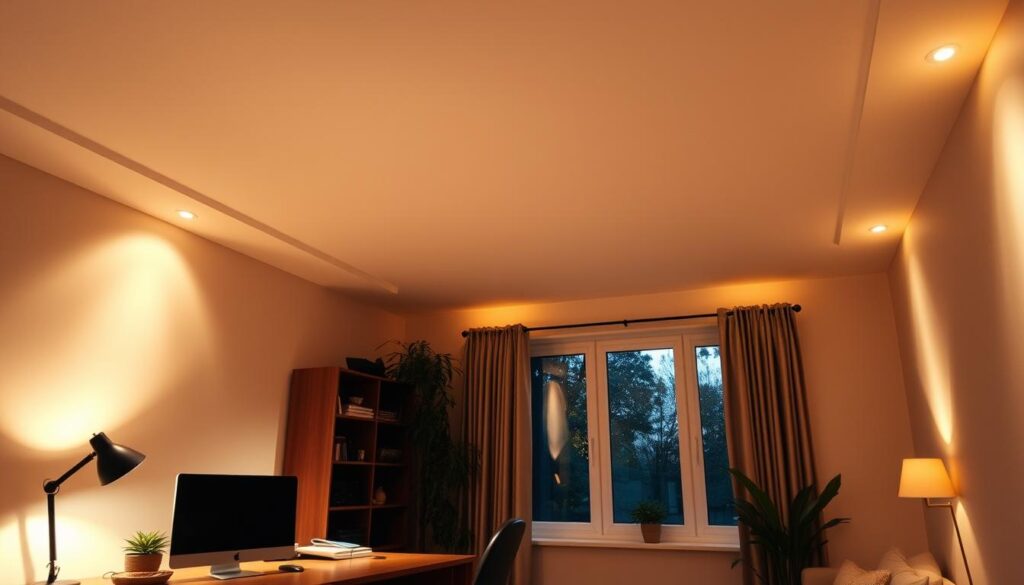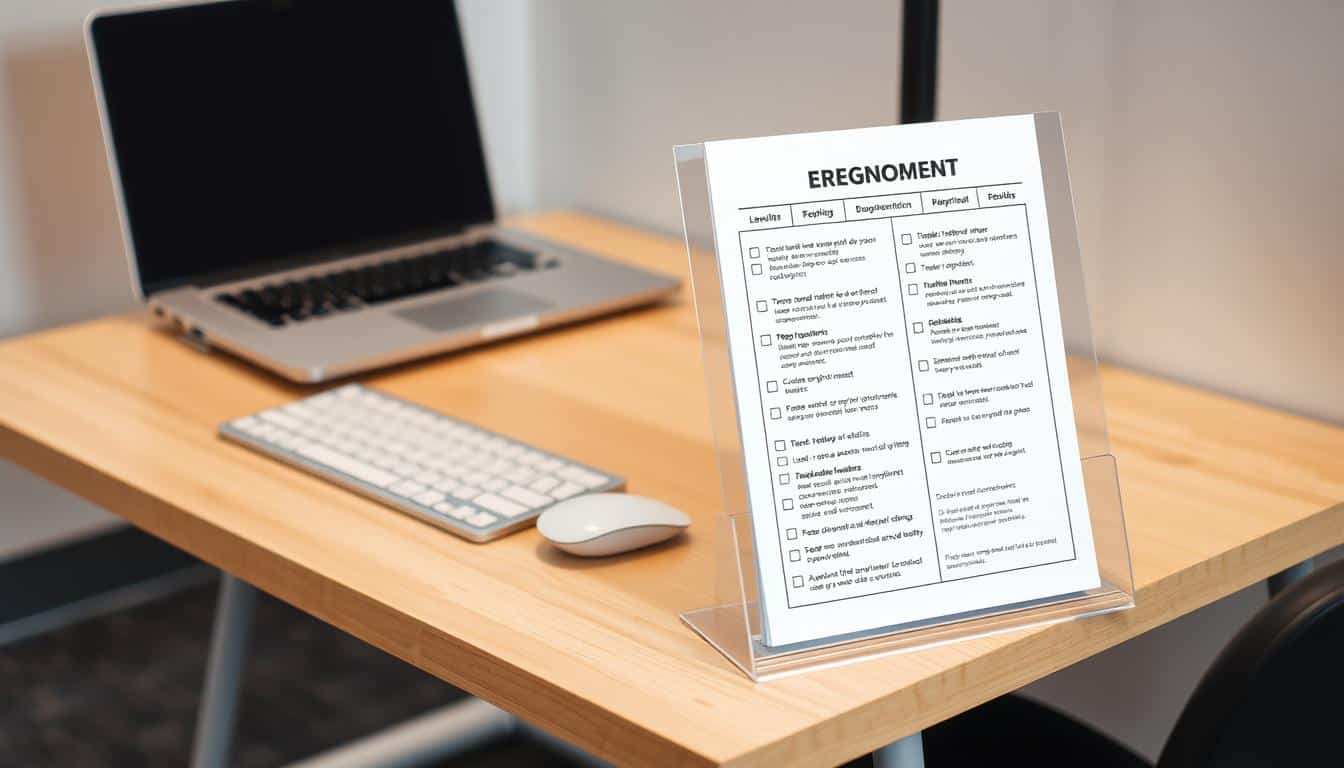Effective ergonomic desk lighting boosts comfort and productivity, especially in spaces with low ceilings. It lights up your work area, cuts down on tiredness, and boosts performance. In this guide, we delve into lighting that suits low ceilings and how it enhances work productivity. By using these ergonomic lighting ideas, you can improve your daily tasks and well-being significantly.
Why Proper Lighting Matters in Low Ceiling Environments
In places with low ceilings, getting the lighting right is a big deal. It makes the area look better and helps people be more productive. Experts say we get 85% of our information by seeing. So, good lighting is key.
With the right light, people can focus more easily. This means fewer distractions and better work or study time.
The Impact of Lighting on Productivity
Good lighting in work areas helps a lot with getting more done. It makes sure there are no shadows or dark spots. This makes it easier to see details.
People working in these conditions do their tasks quicker. This makes the whole workplace do better.
Reducing Eye Strain and Fatigue
Bad lighting can cause eye strain and tiredness. It can make it tough for people to keep focused. The right kind of light reduces glare and feels more comfortable.
This is very important in places where the ceiling is low and choices are limited. Choosing the best lighting is key to a healthier work area.

Understanding Lighting Ergonomics
Lighting ergonomics studies how light impacts workspaces. It looks at making lighting better for more comfort and work efficiency. Getting lighting right can boost how well a workspace performs. Knowing what lighting ergonomics means is vital for making a workplace better.
Definition of Lighting Ergonomics
Lighting ergonomics is about understanding how light interacts with humans in work areas. It explores how the quality, amount, and where light is can affect how well people work and feel. By adjusting light properly, workspaces become places where people can do their jobs better.
Benefits of Ergonomic Lighting in Workspaces
Ergonomic lighting brings many positives to workplaces. Important benefits include:
- Improved employee well-being, promoting mental and physical health.
- Enhanced visual clarity, reducing the likelihood of eye strain and fatigue.
- Lower risk of accidents, as proper lighting allows for better visibility of work areas.
- Increased job satisfaction, as workers appreciate a well-lit environment conducive to productivity.
Types of Lighting Fixtures for Low Ceilings
Finding the perfect lights for rooms with low ceilings can make a big difference. There are direct and indirect lighting fixtures, each suited for different needs. Direct lighting targets specific areas, while indirect lighting creates a soft glow in the room.
Direct Lighting Solutions
Direct lighting shines light right where you need it. It’s great for desks and work areas. But, you have to be careful where you place them to avoid shadows. Examples of direct lighting include:
- Recessed cans
- Flush-mount ceiling fixtures
- Wall-mounted sconces
Indirect Lighting Solutions
Indirect lighting is a great choice for low ceilings. It bounces light off the ceiling and walls for a gentle light that doesn’t glare. This makes a room feel cozier and more welcoming. Indirect lighting options include:
- LED strip lights along the edges of ceilings
- Track lighting with adjustable heads
- Light tubes that diffuse light across surfaces
Key Considerations for Ergonomic Desk Lighting
Designing workspace lighting with care improves comfort and work efficiency. It’s crucial to pick the right level of brightness for each task. Different tasks need different lights, so it’s important to choose wisely to meet those needs.
Brightness Levels Based on Task
For tasks like office work, the ideal brightness level ranges from 500 to 1000 lux. The right amount of light reduces eye strain and helps you focus better. Too little light makes you tired, and too much causes glare. Finding the perfect balance is key to a productive environment.
Color Temperature and Its Effects
Color temperature greatly affects the feel of a space. Warm tones, from 2700K to 3000K, create a relaxing atmosphere, perfect for reading. On the other hand, cooler tones between 4000K and 5000K increase alertness and are great for intense tasks. Picking the appropriate color temperature can make a workspace both comfortable and efficient.
Ergonomic Desk Lighting for Low Ceilings
Choosing the right lights for low ceilings is key to a good work area. Ergonomic desk lighting boosts productivity and reduces eye strain. Make sure to pick lights that brighten well without taking over the space.
Choosing the Right Fixtures for Low Heights
For low ceilings, go for lights that are flush-mounted or recessed. This avoids hitting lights with your head, making your space safer and more comfortable. Consider these important factors:
- Light output: Make sure the lights are bright enough for your needs.
- Design: Look for sleek designs that match your room’s style.
- Adjustability: Choose lights that you can point in different directions, depending on what you’re doing.
Designing a Comfortable Workspace
Making a cozy workspace isn’t just about picking the right lights. The setup of the room, the colors, and the decorations matter a lot. Keep these tips in mind:
- Choose light colors for walls and furniture to bounce light around.
- Use a mix of light sources to avoid shadows and get even light.
- Place your desk to make the most of natural light, making sure your desk lights don’t cause glare on screens.
Eliminating Glare and Shadows
In rooms with low ceilings, getting rid of glare and shadows makes the space more comfortable. It also boosts productivity. Using lights that you can adjust is key to making this happen. By following certain steps, people can see better in their work areas and avoid hurting their eyes.
Adjustable Lighting Techniques
Choosing lighting that you can change helps make the light just right for different tasks. Think about these options:
- Install dimmable fixtures to control brightness levels.
- Use task lights that focus on work areas, reducing overall glare.
- Incorporate lamps with adjustable arms for directed lighting.
These approaches help cut down on shadows and give you the light you need for your work. This makes your work area more comfortable.
Reflective Surfaces and Their Impact
Reflective surfaces change the way light fills a room. Choosing matte finishes on walls and desks can stop glare. This softer reflection of light doesn’t just make it easier to see. It also makes the space calm, helping you focus better and keeping your eyes from getting tired.
Integrating Natural Light
Bringing more natural light into work areas makes them better. It boosts work and health. Windows and skylights help natural light enter easily. They make the area look brighter and reduce the need for fake light. Adding natural touches also makes the place more welcoming.
Utilizing Windows and Skylights
Windows and skylights play a big part in letting in natural light. They can:
- Light up dark spots, making the workspace nicer.
- Help save money by cutting down on electric lights.
- Connect us to the outside, making us feel better.
It’s smart to pick window covers that let light in but keep private things private. Skylights are another great choice. They make spaces feel bigger and more open.
Controlling Daylight to Prevent Glare
Natural light is great, but too much can be a problem. Too much bright light can make it hard to work. Here are ways to handle it:
- Set up work areas away from direct sun.
- Use shades or blinds to soften bright light.
- Move skylights to control the light coming in.
These tips help keep light levels comfortable. This way, you get the benefits of natural light without the downsides. It makes the workspace better for everyone.
Choosing the Right Light Bulbs
Picking the right light bulbs is key to good lighting design. Think about how much energy they use and how colors look under their light. There are different types of bulbs, each with its own strengths. They can make a workspace both more comfortable and more productive, especially in areas with low ceilings.
Energy Efficiency of Different Bulb Types
Energy efficiency matters a lot when picking light bulbs. LED bulbs are top-notch because they use little energy and last a long time. CFLs are another good pick. They use less energy than old-style bulbs but still give off plenty of light. Incandescent bulbs might be cheap to buy, but they use more electricity, which means paying more over time.
Color Rendering and Its Importance
The way colors look under artificial light is crucial. Bulbs with a high CRI make colors appear true-to-life and vivid. This is very important in places where you need to see details clearly. LED and CFL bulbs often have better color rendering than older bulbs. This makes them a great choice for spaces where seeing clearly and accurately is key.
Maintaining Your Lighting Systems
Keeping your lighting systems in top shape is crucial, especially in places with low ceilings. This means regularly checking and cleaning your lights to make sure they work well and light up the area as they should. Over time, dust and dirt can make your lights dimmer, which isn’t good for the look or use of the space.
Regular Inspection and Cleaning
Here are the main things you should do often:
- Check the bulbs and fixtures to see if they’re okay.
- Clean off any dust and dirt to keep the lights shining bright.
- Look for any damage or wear that needs fixing.
Doing these things will keep your lights working great. This helps keep the light quality high and the room looking and feeling nice.
Importance of Timely Replacements
Not replacing old or burnt-out bulbs can make your space look bad. Keep these tips in mind:
- Always check for bulbs that have stopped working.
- Switch to bulbs that save energy to cut down on your electric bill.
- Make sure any new bulbs match the old ones in brightness and color.
If you replace things when needed, your office will be more productive and comfortable. This makes for a better workspace for everyone.
Adjusting Work Spaces for Optimal Lighting
Designing a good workspace means thinking about how to arrange everything. It’s important to use both natural and man-made light well. This makes the space better for work and helps avoid eye strain or discomfort.
Furniture Arrangement for Best Light Utilization
How you set up furniture has a big impact on lighting. Putting desks near windows uses natural light to make the area bright. It’s key to not block light or create unwanted shadows. Picking furniture that reflects light will make your space even brighter.
Task Lighting Options and Placement
Add task lighting for better focus in areas where you do close-up work. Desk lamps with options to change brightness are great. They let you adjust to what you need. Make sure to place your lights so they brighten your work area without causing glare. This makes for a comfortable place to work.
Conclusion
Getting the right desk lighting for low ceilings is key. It makes workspaces both functional and comfy. This guide shows how to pick the right lights and keep the brightness just right, helping you work better.
Learning about different lights and their benefits helps people choose what’s best for them. Changing the lights and how furniture is set up also boosts well-being and work output.
Choosing good lighting means low ceilings won’t slow you down. Taking time to make these changes will improve both your health and how well you do your tasks.



